 Recently, US regulators have decided not to impose further increases in capital requirements on US large and mid-sized banks. The increased requirements, proposed in late 2023, would have been stricter than required under the Bank for International Settlements’ Basel framework1 and provoked a fierce backlash, involving public statements by senior bank executives, aggressive lobbying and extensive media campaigns, including an ad-spot during the Superbowl.
Recently, US regulators have decided not to impose further increases in capital requirements on US large and mid-sized banks. The increased requirements, proposed in late 2023, would have been stricter than required under the Bank for International Settlements’ Basel framework1 and provoked a fierce backlash, involving public statements by senior bank executives, aggressive lobbying and extensive media campaigns, including an ad-spot during the Superbowl.
Following bank insolvencies in the USA during 2023, such as Silicon Valley Bank (SVB) and First Republic, which required bailouts from US banking authorities, many commentators argued that the failures were caused by the institutions having insufficient capital to cover losses on their portfolios of US Treasuries. The implication was that banks, particularly mid-sized ones (which were exempt from the Basel framework), needed to have more capital.
US regulators duly responded by proposing what was officially known as ‘the finalisation of Basel III’, but was commonly referred to as ‘the Basel Endgame’. The proposed system-wide reforms involved more conservative calculations of the risk-weighted value of assets such as mortgages, corporate loans and loans to other financial institutions. Further, the proposals also sought to subject banks with $100bn to $250bn of assets to Basel capital adequacy requirements for the first time. Previously they applied only to banks with over $250bn of assets.
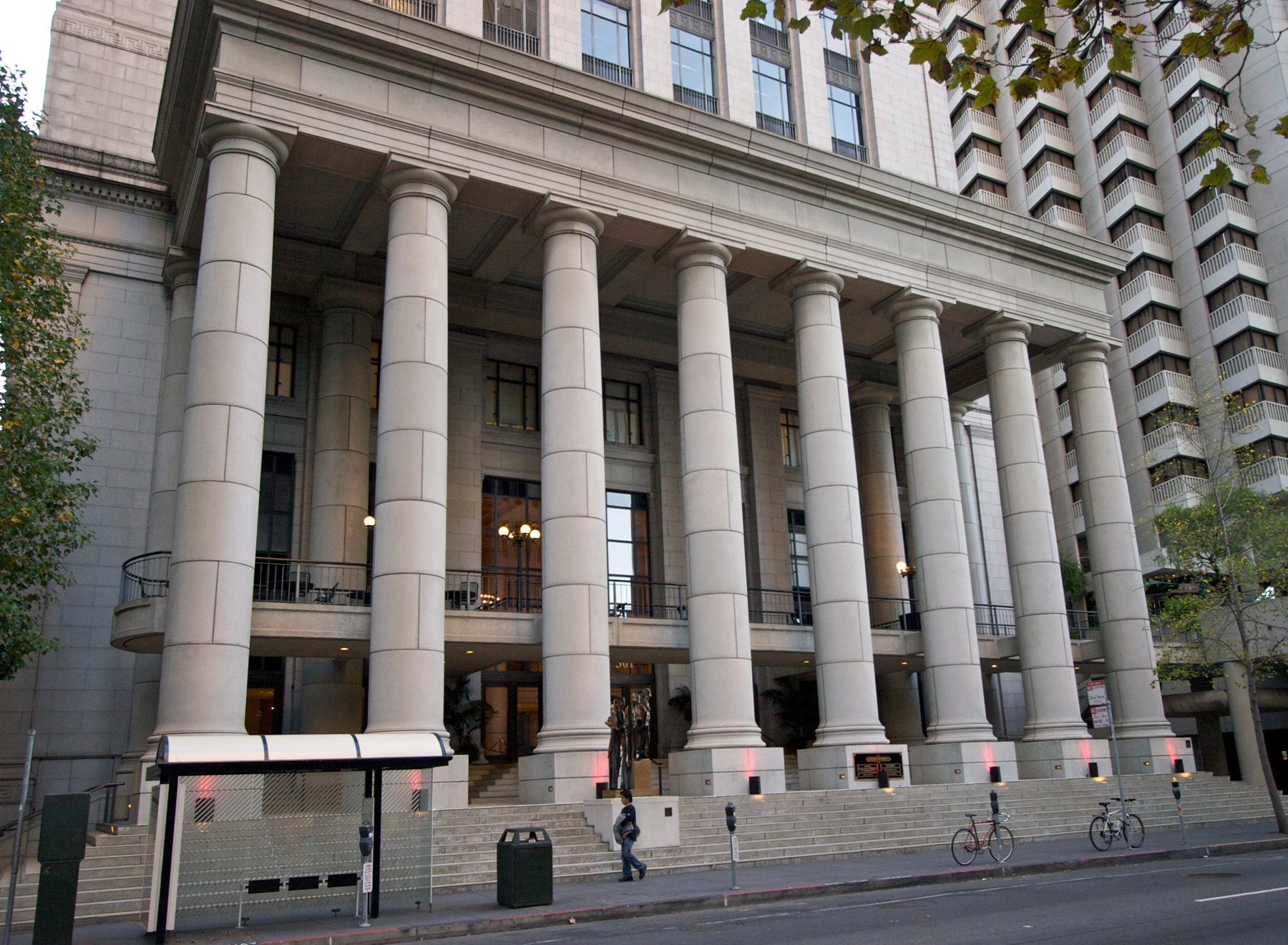 The issue focused attention on the capital banks hold to protect against insolvency and provoked discussion about how much of a capital buffer these institutions should have.
The issue focused attention on the capital banks hold to protect against insolvency and provoked discussion about how much of a capital buffer these institutions should have.
Critics argued the changes would lead to significant increases in the capital required to be held by all US banks compared to international rivals and have an adverse effect on their profitability and international competitiveness. Further, critics pointed out that problems at SVB and First Republic were down to confidence issues and it was argued that more capital would not have saved those institutions from insolvency.
This blog examines these issues. It analyses the role of capital in banks and discusses the trade-off that banks face between profitability and security in their activities which underpinned their resistance to the proposed increases. I will also discuss the other trade-off that banks face – between liquidity and profitability – and how liquidity is just as important an influence on bank’s survival in times of crisis.
The role of capital in banks
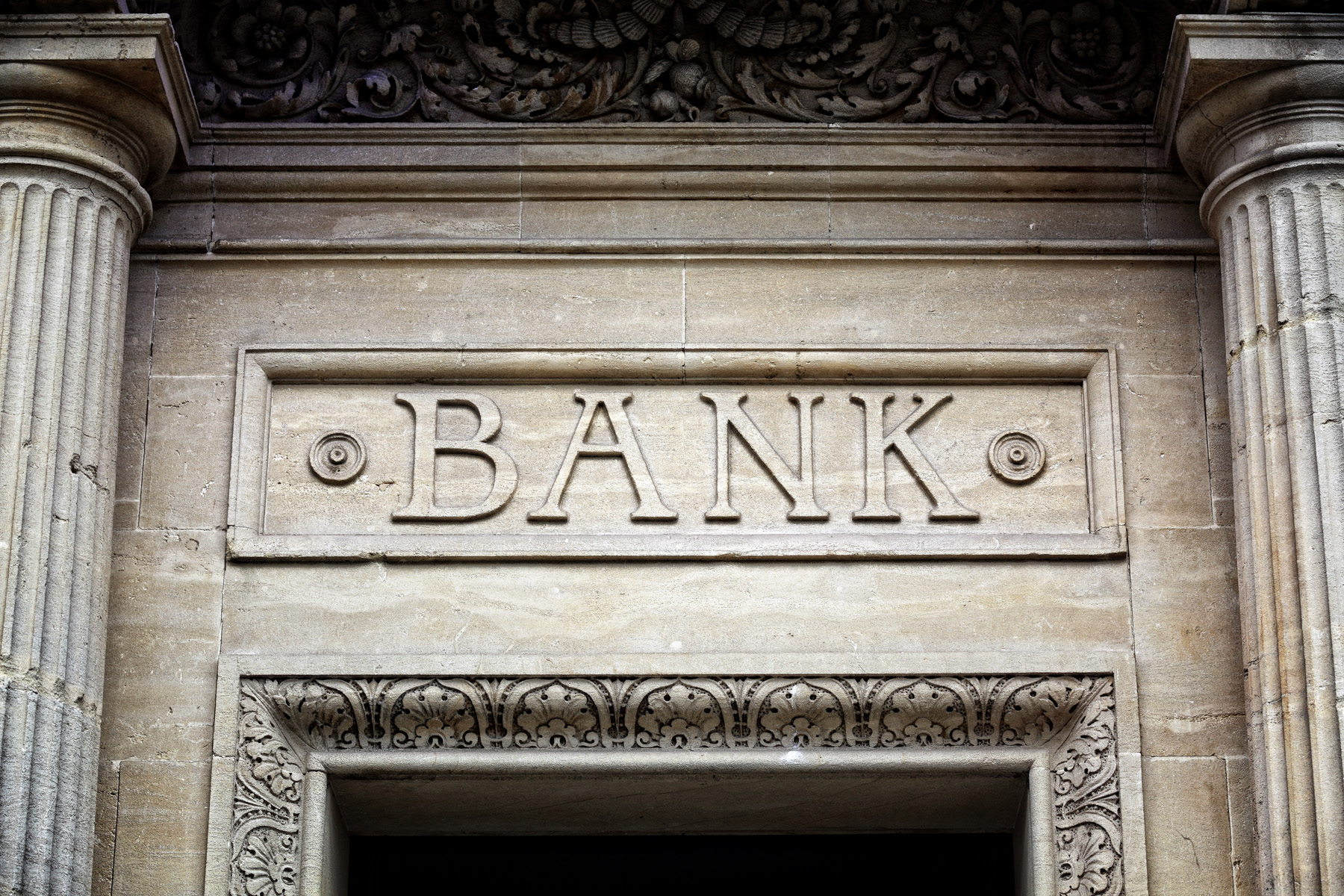 As with any limited company, a bank’s capital is the difference between total assets and its liabilities. It is the funding provided by long-term investors. These are primarily shareholders, but also long-term debtholders. Bank capital acts as a buffer to prevent insolvency. Capital represents the amount that the value of assets have to fall before the bank is insolvent (value of assets is below liabilities). Higher capital provides a greater buffer. Lower capital provides a smaller buffer.
As with any limited company, a bank’s capital is the difference between total assets and its liabilities. It is the funding provided by long-term investors. These are primarily shareholders, but also long-term debtholders. Bank capital acts as a buffer to prevent insolvency. Capital represents the amount that the value of assets have to fall before the bank is insolvent (value of assets is below liabilities). Higher capital provides a greater buffer. Lower capital provides a smaller buffer.
Capital is uniquely important for commercial banks compared to non-financial companies because of the nature of the assets banks hold – financial securities and loans. Banks are susceptible to losses from financial securities and ‘bad debts’, which are directly reflected in the value of their capital. Further, unlike non-financial companies, the failure of a bank has a significantly negative impact on wider economic activity.
The trade-off between profitability and security
As limited companies, banks face a trade-off between profitability and security in lending. The more profitable a loan, the more risky (less secure) it is likely to be. This creates the potential for the interests of deposit holders and regulators on the one hand and bank executives and shareholders on the other to diverge.
Depositors place their funds with banks and will want the bank to be secure, holding lots of capital to prevent insolvency. However, bank executives and shareholders have a strong incentive to lower the capital buffer, particularly equity, because it produces a higher return for shareholders.
Let’s analyse the implications of different capital buffers on profitability and return, particularly the return to shareholders. A performance measure used to analyse the return to shareholders is Return on Equity (RoE) – the amount of profit each pound of equity capital generates, expressed as a percentage. It is calculated by dividing net profit by equity capital and multiplying by 100.

If a bank has a net profit of £1m and holds £10m of equity capital, the RoE is:

If it has a net profit of £1m and holds £5m of equity capital, the RoE is:

In the first case, the capital buffer generates a 10 per cent RoE. In the second case, the lower capital buffer generates a higher RoE of 20 per cent. This provides a simple illustration of the trade-off banks face. The lower the amount of capital they hold, the higher the return to shareholders but the lower capital buffer, which increases the risk of insolvency.
In different time periods, banks have held varying percentages of capital. For much of the 20th century, banks had capital ratios of around 20 per cent, generating a return on equity of between 5 and 10 per cent. Bank lending was restricted, with shareholders accepting a lower return on equity, while holding a higher amount of capital to cover potential losses from financial assets. Indeed, in the 19th century, banks typically held even more capital, amounting to about 50 per cent of their assets, making bank lending even more restricted.
However, starting from the 1960s, but accelerating during the 1980s, banks began to change their view of the trade-off between profitability and security. This coincided with the liberalisation of credit markets and a greater emphasis on ‘shareholder value’ in business. Average capital ratios fell from over 20 per cent in the 1960s to below 10 per cent in the early 2000s. The return on equity went in the opposite direction. In the 1960s, it was typically between 5 and 10 per cent; by the decade before the 2008 financial crisis it had risen to above 20 per cent. The trade-off had shifted in favour of profitability.
 However, the dangers of this shift were exposed during the 2008 financial crisis. The capital held by banks was very thin and not designed to cope with extremely stressful economic circumstances. Banks found they had insufficient capital to cover losses from big decreases in the value of their securitised debt instruments like CDOs (collateralised debt obligations) and struggled to raise additional capital from worried investors.
However, the dangers of this shift were exposed during the 2008 financial crisis. The capital held by banks was very thin and not designed to cope with extremely stressful economic circumstances. Banks found they had insufficient capital to cover losses from big decreases in the value of their securitised debt instruments like CDOs (collateralised debt obligations) and struggled to raise additional capital from worried investors.
After the crisis, the Bank of International Settlements (BIS) determined that banks needed to hold sufficient capital, not just to cope with the ebbs and flows of the business cycle but also as a buffer in the rare, yet extremely stressful, economic circumstances that might arise. Therefore, international bank regulations were redrafted under the auspices of the BIS’s Basel Committee. The third version of these regulations is known as ‘Basel III’. It was agreed in 2017, with the measures being phased in from 2022. Basel III significantly raised the capital buffers for large global banks, known as ‘globally systemically-important banks’ (G-SIBs) and the use of stress-tests to model the robustness of banks’ balance sheets to cope with severe economic pressures.
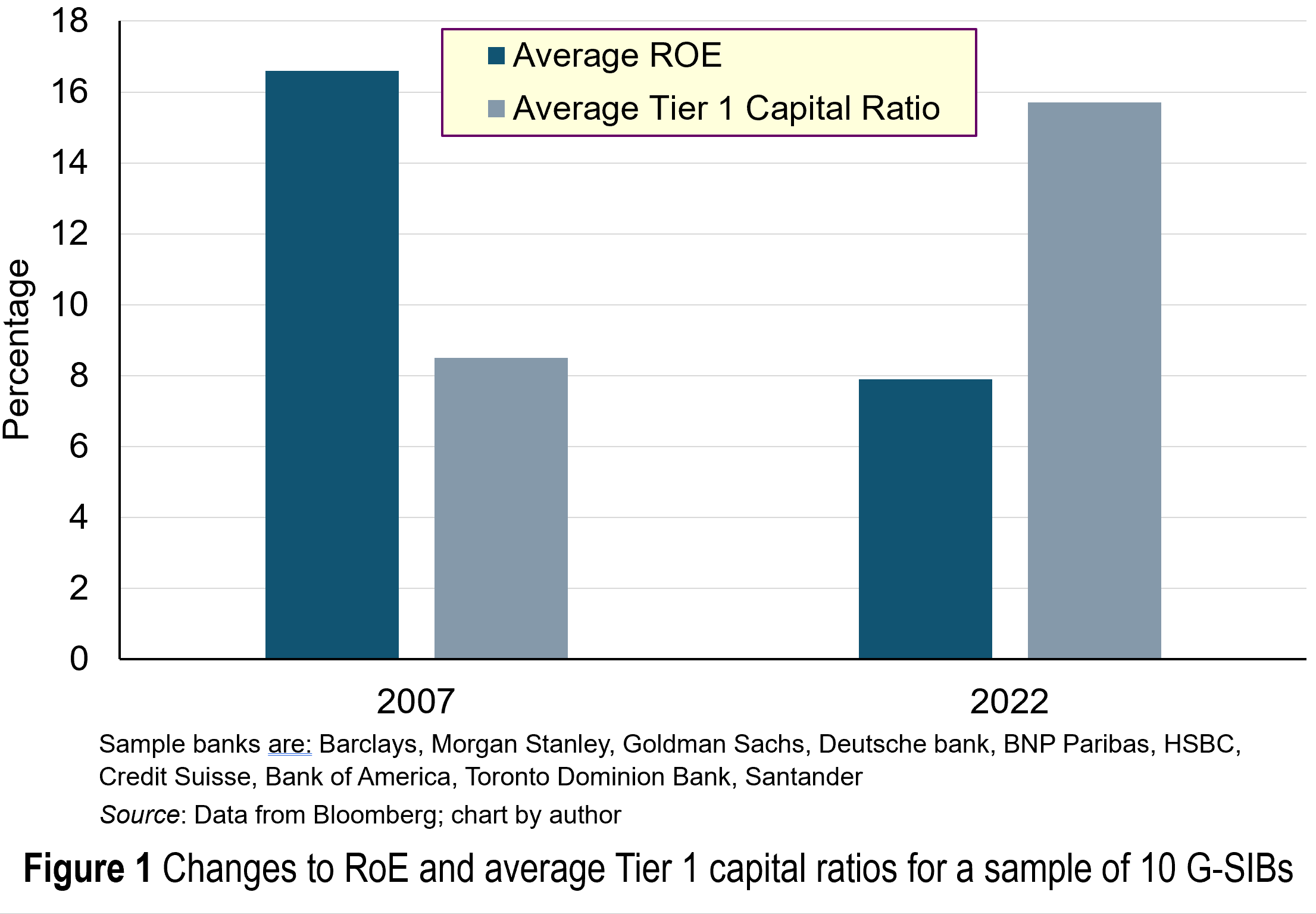 Figure 1 shows the changes to the average return on equity (RoE) and average tier 1 capital ratios for a sample of 10 G-SIBs as a result of Basel III. By 2022, all the banks had capital buffers which were well above the minimum required under Basel III for tier 1 capital – 8.5 per cent. The trade-off was that banks’ average return on equity was much lower – around 8 per cent in 2022, compared to 16 per cent in 2007.
Figure 1 shows the changes to the average return on equity (RoE) and average tier 1 capital ratios for a sample of 10 G-SIBs as a result of Basel III. By 2022, all the banks had capital buffers which were well above the minimum required under Basel III for tier 1 capital – 8.5 per cent. The trade-off was that banks’ average return on equity was much lower – around 8 per cent in 2022, compared to 16 per cent in 2007.
How much capital is enough capital?
Ever since the Basel III agreement, there had been discussions around tightening capital requirements further but no agreement had been reached. One aspect of Basel III was that increased capital was only required of the largest banks. Mid-sized and smaller banks, which are a significant part of the US market, were exempt. The failures of the mid-sized US Silicon Valley Bank (SVB) and First Republic Bank provoked unilateral proposals by the US authorities through the ‘Basel Endgame’. This would raise capital requirements for large banks and extend capital requirements to mid-sized institutions.
But large US banks resisted these proposals, arguing that the authorities were pushing the trade-off too far in favour of security, attempting to make banks very safe but offering a poor return for investors and decreasing the amount of lending banks would conduct.
The furore raises the question as to what is an adequate amount of capital. One reference point is non-financial institutions. These typically hold much more capital relative to the value of total assets – in the range from 30 per cent to 40 per cent. If banks had capital ratios at that level, or even higher, they would be perceived as extremely safe, but might not offer much return to shareholders, impinging on the ability of banks to raise additional capital when they needed it.
Further, other critics argue that there is too much emphasis placed on capital adequacy. Focusing on capital ignores the other significant trade-off banks face in their activities – between liquidity and profitability. Indeed, recent bank failures were not due to insufficient capital but other problems relating to the management of the institution, which led to a loss of confidence by not only by investors, but primarily, deposit-holders.
The other trade-off: liquidity and profitability
 While banks have to be solvent, they have to manage their trade-off between liquidity and profitability carefully too. A commercial bank’s basic business model involves maturity transformation – transforming liquid deposits into illiquid assets, such as government bonds and loans, to generate profit. This requires balancing the desire for profitability with the liquidity needs of depositors. If banks get it wrong, then it can lead to a loss of confidence and a ‘run’ on deposits. This is what happened to both Silicon Valley Bank (SVB) and Credit Suisse. The failures of both institutions were not due to insufficient capital but poor liquidity management, which eventually caused a loss of confidence.
While banks have to be solvent, they have to manage their trade-off between liquidity and profitability carefully too. A commercial bank’s basic business model involves maturity transformation – transforming liquid deposits into illiquid assets, such as government bonds and loans, to generate profit. This requires balancing the desire for profitability with the liquidity needs of depositors. If banks get it wrong, then it can lead to a loss of confidence and a ‘run’ on deposits. This is what happened to both Silicon Valley Bank (SVB) and Credit Suisse. The failures of both institutions were not due to insufficient capital but poor liquidity management, which eventually caused a loss of confidence.
Silicon Valley Bank (SVB) demonstrated poor liquidity management, involving a narrow depositor base which was very responsive to changes in interest rates, and an illiquid asset portfolio. During the coronavirus pandemic, tech start-ups received substantial venture capital funding and deposited it with SVB. SVB did not have the capacity or inclination to lend all of the extensive deposits which they were receiving. Instead, the management decided to invest in long-term fixed rate government debt securities. Such securities represented 56 per cent of SVB’s assets in 2020.
Since SVB’s depositors were businesses, unlike retail depositors they were more sensitive to changing interest rates. As rates rose, businesses moved their funds out in search of higher rates, creating a liquidity problem for SVB. The bank was forced to sell $21bn of its long-dated bonds to provide liquidity. However, it endured losses when it sold the bonds as bond prices had fallen, reflecting higher interest rates. Therefore, it needed to raise capital to replace the losses from those sales.
Investors baulked at this, however, particularly when they observed the accelerating deposit outflows. It was the ‘run’ on deposits that was the problem ($42 billion on 8 March 2023 alone), not the unrealised losses on government bonds relative to capital. It was only when the losses were realised that the problem arose. Indeed, Bank of America was in a similar situation with a substantial portfolio of long-term government debt. However, it did not have to realise its ‘paper losses’ since its deposits were more ‘sticky’.
 Once confidence is lost and there is a run on deposits, even a bank which has a capital buffer deemed to be more than sufficient is doomed to fail. Take Credit Suisse. It was subject to the Basel framework and had capital ratios similar to its ultimate acquirer UBS. However, it had a risky business culture that pushed the trade-off too much towards profitability. This led to repeated scandals, fines and losses, which caused investors to lose confidence in the institution.
Once confidence is lost and there is a run on deposits, even a bank which has a capital buffer deemed to be more than sufficient is doomed to fail. Take Credit Suisse. It was subject to the Basel framework and had capital ratios similar to its ultimate acquirer UBS. However, it had a risky business culture that pushed the trade-off too much towards profitability. This led to repeated scandals, fines and losses, which caused investors to lose confidence in the institution.
But, once again, it was not the financial losses that was the problem. It was the loss of confidence by depositors. The institution suffered deposit withdrawals of CHF 67 billion in the first three months of 2023. Attempts to stem the outflow with a ‘liquidity backstop’ provided by the Swiss National Bank on 15 March 2023 failed to reassure investors and depositors. Instead, the bank run intensified, with daily withdrawals of demand deposits topping CHF 10bn in the week afterwards. Credit Suisse failed and the Swiss banking regulators quickly forced its acquisition by UBS.
Conclusion
Bank capital is important. After the financial crisis, banks needed to redress the trade-off between profitability and security in lending. However, while the US authorities desire to improve the security of their banking system is laudable, the focus on capital is misplaced. Ever-increasing capital is not the solution to every banking crisis.
Ultimately, banks depend on confidence. Once that confidence is lost, there is little an institution can do to prevent failure. More emphasis needs to be placed on better management of assets and liabilities to maintain sufficient profitability, while at the same time being both liquid and secure. This will maintain confidence, not only by investors, but particularly by deposit-holders.
1 See Economics 11e, section 18.2; Economics for Business 9e, section 28.2; Essentials of Economics 9e, section 11.2.
Articles
- Basel III: The US has started a race to the bottom
Financial Times, Daniel Davies (14/9/24)
- Basel III: What It Is, Capital Requirements, and Implementation
Investopedia, Peter Gratton (22/6/24)
- BofA: dumb, or just unlucky?
Financial Times, Robert Armstrong (30/6/24)
- Why America’s banks need more capital
The Economist (19/10/23)
- The Fed gets ratioed, bank capital edition
Financial Times, Steven Kelly (31/8/23)
- The US pushback against ‘Basel Endgame’
Financial Times, Laura Noonan, Claire Jones and Joshua Franklin (19/3/24)
- SVB is not a canary in the banking gold mine
Financial Times, Robert Armstrong (10/3/23)
- Basel Endgame stumbles at the finish line
The Banker, Farah Khalique (16/7/24)
- Why did Silicon Valley Bank fail?
Economics Observatory, John Turner (17/3/23)
- Why did Credit Suisse fail and what does it mean for banking regulation?
Economics Observatory, Rebecca Stuart (13/4/23)
Video
Blog
Information
Questions
- Explain the role of capital for a commercial bank.
- Research the ‘Basel Endgame’ proposals. Why would US regulators want banks to hold more capital?
- Explain the trade-off between profitability and security that banks face.
- Explain the trade-off between profitability and liquidity that banks face.
- Research Silicon Valley Bank’s failure and trace the ‘run’ on deposits in the bank. Explain why investors baulked at injecting more capital.
- Research Credit Suisse’s demise and trace the ‘run’ on deposits in that bank. Explain why investors baulked at injecting more capital.
 Ten years ago, the financial crisis deepened and stock markets around the world plummeted. The trigger was the collapse of Lehman Brothers, the fourth-largest US investment bank. It filed for bankruptcy on September 15, 2008. This was not the first bank failure around that time. In 2007, Northern Rock in the UK (Aug/Sept 2007) had collapsed and so too had Bear Stearns in the USA (Mar 2008).
Ten years ago, the financial crisis deepened and stock markets around the world plummeted. The trigger was the collapse of Lehman Brothers, the fourth-largest US investment bank. It filed for bankruptcy on September 15, 2008. This was not the first bank failure around that time. In 2007, Northern Rock in the UK (Aug/Sept 2007) had collapsed and so too had Bear Stearns in the USA (Mar 2008).
Initially there was some hope that the US government would bail out Lehmans. But when Congress rejected the Bank Bailout Bill on September 29, the US stock market fell sharply, with the Dow Jones falling by 7% the same day. This was mirrored in other countries: the FTSE 100 fell by 15%.
At the core of the problem was excessive lending by banks with too little capital. What is more, much of the capital was of poor quality. Many of the banks held securitised assets containing ‘sub-prime mortgage debt’. The assets, known as collateralised debt obligations (CDOs), were bundles of other assets, including mortgages. US homeowners had been lent money based on the assumption that their houses would increase in value. When house prices fell, homeowners were left in a position of negative equity – owing more than the value of their house. With many people forced to sell their houses, prices fell further. Mortgage debt held by banks could not be redeemed: it was ‘sub-prime’ or ‘toxic debt’.
Response to the crisis
The outcome of the financial crash was a series of bailouts of banks around the world. Banks cut back on lending and the world headed for a major recession.
Initially, the response of governments and central banks was to stimulate their economies through fiscal and monetary policies. Government spending was increased; taxes were cut; interest rates were cut to near zero. By 2010, the global economy seemed to be pulling out of recession.
However, the expansionary fiscal policy, plus the bailing out of banks, had led to large public-sector deficits and growing public-sector debt. Although a return of economic growth would help to increase revenues, many governments felt that the size of the public-sector deficits was too large to rely on economic growth.
As a result, many governments embarked on a period of austerity – tight fiscal policy, involving cutting government expenditure and raising taxes. Although this might slowly bring the deficit down, it slowed down growth and caused major hardships for people who relied on benefits and who saw their benefits cut. It also led to a cut in public services.
 Expanding the economy was left to central banks, which kept monetary policy very loose. Rock-bottom interest rates were then accompanied by quantitative easing. This was the expansion of the money supply by central-bank purchases of assets, largely government bonds. A massive amount of extra liquidity was pumped into economies. But with confidence still low, much of this ended up in other asset purchases, such as stocks and shares, rather than being spent on goods and services. The effect was a limited stimulation of the economy, but a surge in stock market prices.
Expanding the economy was left to central banks, which kept monetary policy very loose. Rock-bottom interest rates were then accompanied by quantitative easing. This was the expansion of the money supply by central-bank purchases of assets, largely government bonds. A massive amount of extra liquidity was pumped into economies. But with confidence still low, much of this ended up in other asset purchases, such as stocks and shares, rather than being spent on goods and services. The effect was a limited stimulation of the economy, but a surge in stock market prices.
With wages rising slowly, or even falling in real terms, and with credit easy to obtain at record low interest rates, so consumer debt increased.
Lessons
So have the lessons of the financial crash been learned? Would we ever have a repeat of 2007–9?
On the positive side, financial regulators are more aware of the dangers of under capitalisation. Banks’ capital requirements have increased, overseen by the Bank for International Settlements. Under its Basel II and then Basel III regulations (see link below), banks are required to hold much more capital (‘capital buffers’). Some countries’ regulators (normally the central bank), depending on their specific conditions, exceed these the Basel requirements.
But substantial risks remain and many of the lessons have not been learnt from the financial crisis and its aftermath.
There has been a large expansion of household debt, fuelled by low interest rates. This constrains central banks’ ability to raise interest rates without causing financial distress to people with large debts. It also makes it more likely that there will be a Minsky moment, when a trigger, such as a trade war (e.g. between the USA and China), causes banks to curb lending and consumers to rein in debt. This can then lead to a fall in aggregate demand and a recession.
Total debt of the private and public sectors now amounts to $164 trillion, or 225% of world GDP – 12 percentage points higher than in 2009.
China poses a considerable risk, as well as being a driver of global growth. China has very high levels of consumer debt and many of its banks are undercapitalised. It has already experienced one stock market crash. From mid-June 2015, there was a three-week fall in share prices, knocking about 30% off their value. Previously the Chinese stock market had soared, with many people borrowing to buy shares. But this was a classic bubble, with share prices reflecting exuberance, not economic fundamentals.
It has already experienced one stock market crash. From mid-June 2015, there was a three-week fall in share prices, knocking about 30% off their value. Previously the Chinese stock market had soared, with many people borrowing to buy shares. But this was a classic bubble, with share prices reflecting exuberance, not economic fundamentals.
Although Chinese government purchases of shares and tighter regulation helped to stabilise the market, it is possible that there may be another crash, especially if the trade war with the USA escalates even further. The Chinese stock market has already lost 20% of its value this year.
Then there is the problem with shadow banking. This is the provision of loans by non-bank financial institutions, such as insurance companies or hedge funds. As the International Business Times article linked below states:
A mind-boggling study from the US last year, for example, found that the market share of shadow banking in residential mortgages had rocketed from 15% in 2007 to 38% in 2015. This also represents a staggering 75% of all loans to low-income borrowers and risky borrowers. China’s shadow banking is another major concern, amounting to US$15 trillion, or about 130% of GDP. Meanwhile, fears are mounting that many shadow banks around the world are relaxing their underwriting standards.
Another issue is whether emerging markets can sustain their continued growth, or whether troubles in the more vulnerable emerging-market economies could trigger contagion across the more exposed parts of the developing world and possibly across the whole global economy. The recent crises in Turkey and Argentina may be a portent of this.
 Then there is a risk of a cyber-attack by a rogue government or criminals on key financial insitutions, such as central banks or major international banks. Despite investing large amounts of money in cyber-security, financial institutions worry about their vulnerability to an attack.
Then there is a risk of a cyber-attack by a rogue government or criminals on key financial insitutions, such as central banks or major international banks. Despite investing large amounts of money in cyber-security, financial institutions worry about their vulnerability to an attack.
Any of these triggers could cause a crisis of confidence, which, in turn, could lead to a fall in stock markets, a fall in aggregate demand and a recession.
Finally there is the question of the deep and prolonged crisis in capitalism itself – a crisis that manifests itself, not in a sudden recession, but in a long-term stagnation of the living standards of the poor and ‘just about managing’. Average real weekly earnings in many countries today are still below those in 2008, before the crash. In Great Britain, real weekly earnings in July 2018 were still some 6% lower than in early 2008.
Articles
- The Lehman Brothers Crash And The Chaos That Followed – Everything You Need To Know
HuffPost, Isabel Togoh (15/9/18)
- Ten years after the crash: have the lessons of Lehman been learned?
The Guardian, Yanis Varoufakis, Ann Pettifor, Mark Littlewood, David Blanchflower, Olli Rehn, Nicky Morgan and Micah White (14/9/18)
- Financial crisis 10 years on: Who are the winners and losers?
Independent, Kate Hughes (14/9/18)
- Investment winners and losers 10 years after the crash
Financial Times, Kate Beioley (14/9/18)
- Nine Lessons From the Global Financial Crisis
Bloomberg, Mohamed A. El-Erian (13/9/18)
- Lehman — why we need a change of mindset
Deutsche Welle, Thomas Straubhaar (14/9/18)
- ‘The world is sleepwalking into a financial crisis’ – Gordon Brown
The Guardian, Larry Elliott (12/9/18)
 Economists warn of new financial crisis on anniversary of 2008 crash
Economists warn of new financial crisis on anniversary of 2008 crashChannel 4 news, Helia Ebrahimi (15/9/18)
- Financial crisis 2008: Five biggest risks of a new crash
International Business Times, Nafis Alam (14/9/18)
- Carney warns against complacency on 10th anniversary of financial crisis
BBC News, Kamal Ahmed (12/9/18)
- A cyberattack could trigger the next financial crisis, new report says
CNBC, Bob Pisani (13/9/18)
Information and data
Questions
- Explain the major causes of the financial market crash in 2008.
- Would it have been a good idea to have continued with expansionary fiscal policy beyond 2009?
- Summarise the Basel III banking regulations.
- How could quantitative easing have been differently designed so as to have injected more money into the real sector of the economy?
- What are the main threats to the global economy at the current time? Are any of these a ‘hangover’ from the 2007–8 financial crisis?
- What is meant by ‘shadow banking’ and how might this be a threat to the future stability of the global economy?
- Find data on household debt in two developed countries from 2000 to the present day. Chart the figures. Explain the pattern that emerges and discuss whether there are any dangers for the two economies from the levels of debt.
 Ten years ago (on 9 August 2007), the French bank BNP Paribas sparked international concern when it admitted that it didn’t know what many of its investments in the US sub-prime property market were worth and froze three of its hedge funds. This kicked off the financial crisis and the beginning of the credit crunch.
Ten years ago (on 9 August 2007), the French bank BNP Paribas sparked international concern when it admitted that it didn’t know what many of its investments in the US sub-prime property market were worth and froze three of its hedge funds. This kicked off the financial crisis and the beginning of the credit crunch.
In September 2007 there was a run on the Northern Rock bank in the UK, forcing the Bank of England to provide emergency funding. Northern Rock was eventually nationalised in February 2008. In July 2008, the US financial authorities had to provide emergency assistance to America’s two largest mortgage lenders, Fannie Mae and Freddie Mac.
Then in September 2008, the financial crisis really took hold. The US bank, Lehman Brothers, filed for bankruptcy, sending shock waves around the global economy. In the UK, Lloyds TSB announced that it was taking over the UK’s largest mortgage lender, Halifax Bank Of Scotland (HBOS), after a run on HBOS shares.
Later in the month, Fortis, the huge Belgian banking, finance and insurance company, was partly nationalised to prevent its bankruptcy. Also the UK government was forced to take control of mortgage-lender, Bradford & Bingley’s, mortgages and loans, with the rest of the business sold to Santander.
Early in October 2008, trading was suspended in the main Icelandic banks. Later in the month, the UK government announced a £37 billion rescue package for Royal Bank of Scotland (RBS), Lloyds TSB and HBOS. Then in November it partially nationalised RBS by taking a 58% share in the bank. Meanwhile various other rescue packages and emergency loans to the banking sector were taking place in other parts of the world. See here for a timeline of the financial crisis.

So, ten years on from the start of the crisis, have the lessons of the crisis been learnt. Could a similar crisis occur again?
The following articles look at this question and the answers are mixed.
On the positive side, banks are much more highly capitalised than they were ten years ago. Moves by the Basel Committee on Banking Supervision in its Basel III regulatory framework have ensured that banks are much more highly capitalised and operate with higher levels of liquidity. What is more, banks are generally more cautious about investing in highly complex and risky collateralised assets.
On the negative side, increased flexibility in labour markets, although helping to keep unemployment down, has allowed a huge squeeze on real wages as austerity measures have dampened the economy. What is more, household debt is rising to possibly unsustainable levels. Over the past year, unsecured debt (e.g. personal loans and credit card debt) have risen by 10% and yet (nominal) household incomes have risen by only 1.5%. While record low interest rates make such loans relatively affordable, when interest rates do eventually start to rise, this could put a huge strain on household finances. But if households start to rein in their borrowing, this would put downward pressure on aggregate demand and jeopardise economic growth.
Articles
- The crisis: 10 years in three chart
BBC News, Simon Jack (9/8/17)
 Darling: ‘Alarm bells ringing’ for UK economy
Darling: ‘Alarm bells ringing’ for UK economyBBC News (9/8/17)
- Alistair Darling warns against ‘complacency’ 10 years on from financial crisis
The Telegraph (9/8/17)
- A decade after the financial crisis consumers are still worried
Independent, Kate Hughes (9/8/17)
- Bankers still do not understand complex reasons behind financial crash, senior politician warns
Independent, Ashley Cowburn (9/8/17)
- We let the 2007 financial crisis go to waste
The Guardian, Torsten Bell (9/8/17)
- Bank of England warns of complacency over big rise in personal debt
The Guardian, Larry Elliott (24/7/17)
- On the 10th anniversary of the global financial meltdown, here’s what’s changed
USA Today, Kim Hjelmgaard (8/8/17)
- Financial crisis: Ten years ago today the tremors started
Irish Times (9/8/17)
 If We Are Racing to the Pre-Crisis Bubble, Here Are 12 Charts To Watch
If We Are Racing to the Pre-Crisis Bubble, Here Are 12 Charts To WatchBloomberg, Sid Verma (9/8/17)
Videos
Questions
- Explain what are meant by ‘collateralised debt obligations (CDOs)’.
- What part did CDOs play in the financial crisis of 2007–8?
- In what ways is the current financial situation similar to that in 2007–8?
- In what ways is it different?
- Explain the Basel III banking regulations.
- To what extent has the Bank of England exceeded the minimum Basel III requirements?
- Explain what is meant by ‘stress testing’ the banks? Does this ensure that there can never be a repeat of the financial crisis?
- Why is it desirable for central banks eventually to raise interest rates to a level of around 2–3%? Why might it be difficult for central banks to do that?
 Under the auspices of the Bank for International Settlements (BIS), banks around the world are working their way towards implementing tougher capital requirements. These tougher rules, known as ‘Basel III’, are due to come fully into operation by 2019.
Under the auspices of the Bank for International Settlements (BIS), banks around the world are working their way towards implementing tougher capital requirements. These tougher rules, known as ‘Basel III’, are due to come fully into operation by 2019.
This third version of international banking rules was agreed after the financial crisis of 2008, when many banks were so undercapitalised that they could not withstand the dramatic decline in the value of many of their assets and a withdrawal of funds.
Basel III requires banks to have much more capital, especially common equity capital. The point about equity (shares) is that it’s a liability that does not have to be repaid. If people hold bank shares, the bank does not have to repay them and does not even have to pay any dividends. In other words, the money raised by issuing shares carries no obligation on the part of the bank and can thus provide a buffer against large-scale withdrawal of funds.
Under Basel III, banks have to maintain sufficiently large ‘capital-adequacy ratios’. As Essentials of Economics (7th edition) explains:
Capital adequacy is a measure of a bank’s capital relative to its assets, where the assets are weighted according to the degree of risk. The more risky the assets, the greater the amount of capital that will be required.
A measure of capital adequacy is given by the capital adequacy ratio (CAR). This is given by the following formula:

Common Equity Tier 1 (CET1) capital includes bank reserves (from retained profits) and ordinary share capital (equities), where dividends to shareholders vary with the amount of profit the bank makes… Additional Tier 1 (AT1) capital consists largely of preference shares. These pay a fixed dividend (like company bonds), but although preference shareholders have a prior claim over ordinary shareholders on the company’s (i.e. the bank’s) profits, dividends need not be paid in times of loss.
 Tier 2 capital is subordinated debt with a maturity greater than 5 years. Subordinated debt holders only have a claim on a company (a bank) after the claims of all other bondholders have been met.
Tier 2 capital is subordinated debt with a maturity greater than 5 years. Subordinated debt holders only have a claim on a company (a bank) after the claims of all other bondholders have been met.
Risk-weighted assets are the total value of assets, where each type of asset is multiplied by a risk factor. Under the Basel III accord, cash and government bonds have a risk factor of zero and are thus not included. Interbank lending between the major banks has a risk factor of 0.2 and is thus included at only 20 per cent of its value; residential mortgages under 60% of the value of the property have a risk factor of 0.35; personal loans, credit-card debt and overdrafts have a risk factor of 1; loans to companies carry a risk factor of 0.2, 0.5, 1 or 1.5, depending on the credit rating of the company. Thus the greater the average risk factor of a bank’s assets, the greater will be the value of its risk weighted assets, and the lower will be its CAR.
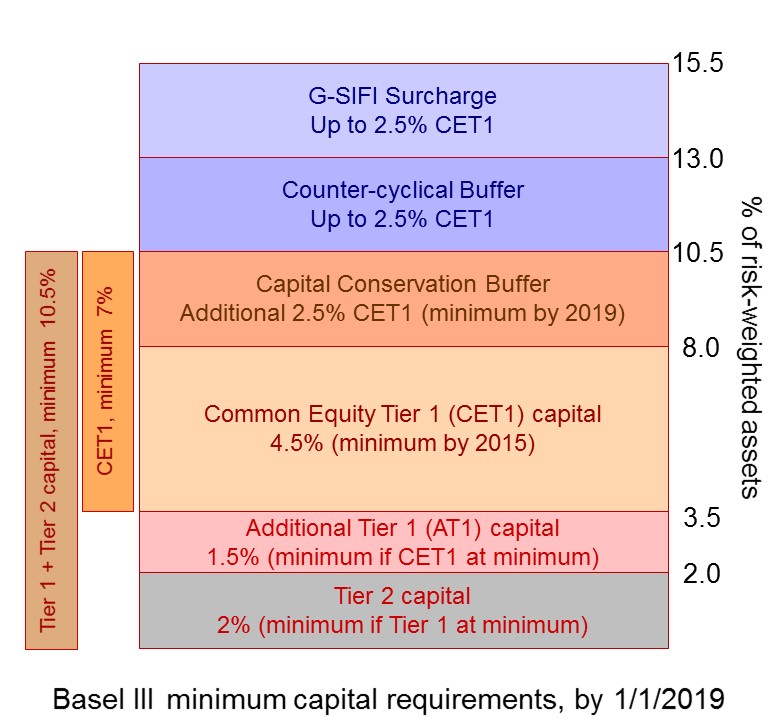 Basel III gives minimum capital requirements that are higher than under its predecessor, Basel II. Thus, by 2019, banks must have a common equity capital to risk-weighted assets of at least 4.5% and a Tier 1 ratio of at least 6.0%. The overall CAR should be at least 8%. In addition, the phased introduction of a ‘capital conservation buffer’ from 2016 will raise the overall CAR to at least 10.5 per cent.
Basel III gives minimum capital requirements that are higher than under its predecessor, Basel II. Thus, by 2019, banks must have a common equity capital to risk-weighted assets of at least 4.5% and a Tier 1 ratio of at least 6.0%. The overall CAR should be at least 8%. In addition, the phased introduction of a ‘capital conservation buffer’ from 2016 will raise the overall CAR to at least 10.5 per cent.
Over the past few years, banks have increased their capital cushions significantly and many have exceeded the Basel III requirements, even for 2019.
But the Basel Committee has been reconsidering the calculation of risk-weighted assets. Because of the complexity of banks’ asset structures, which tend to vary significantly from country to country, it is difficult to ensure that banks’ are meeting the Basel III requirements. Under proposed amendments to Basel III (which some commentators have dubbed ‘Basel IV’), banks would have to compare their own calculations with a ‘standardised’ model. Their own calculations of risk-based assets would then not be allowed to be lower than 60–90% (known as ‘the output floor’) of the standardised approach.
While, on the surface, this may seem reasonable, European banks have claimed that this would penalise them, as some of their assets are less risky than the equivalent assets in other countries. For example, Germany has argued that mortgage defaults have been rare and thus German mortgage debt should be given a lower weighting than US mortgage debt, where defaults have been more common. If all assets were assessed according to the output floor, several banks, especially in Europe, would be judged to be undercapitalised. As The Economist article states:
Analysts at Morgan Stanley estimate that global, non-American banks could see risk-weighted assets rise by an average of 18–30%, depending on the level of the output floor. Extra capital of €250bn–410bn could be needed, a tall order when earnings are thin and investors wary. The committee’s reviews of operational and market risks would add even more.
This question of an output floor was a sticking point at the Basel Committee meeting in Santiago, which ended on 30 November. Although some progress was made about agreeing to rules on risk weighting that could be applied globally, a final agreement will have to wait until the next meeting, in January – at the earliest.
Articles
Basel bust-up: A showdown looms over bank-capital rules The Economist (26/11/16)
Bank regulators fail to agree on new rules Manila Standard (2/12/16)
Bank chief Claudio Borio urges regulators to ‘stay strong’ Weekend Australian, Michael Bennet (29/11/16)
Final Basel III rules meet resistance from Europe The Straits Times (2/12/16)
This Is the Absolutely Worst Time to Weaken Global Bank Rules American Banker, Mayra Rodriguez Valladares (2/12/16)
New Basel banking rules’ impact on European economy Financial Times, Frédéric Oudéa (28/12/16)
Banks like RBS still look risky, but getting too tough could cause greater problems The Conversation, Alan Shipman (1/12/16)
BIS publications
International banking supervisory community meets to discuss the regulatory framework BIS Press Release (1/12/16)
Basel III: international regulatory framework for banks Bank for International Settlements
Basel III phase-in arrangements Basel Committee on Banking Supervision, BIS
Basel Committee on Banking Supervision reforms – Basel III, Summary Table Basel Committee on Banking Supervision, BIS
Questions
- Why do reserves in banks have a zero weighting in terms of risk-based assets?
- What items have a 100% weighting? Explain why.
- Examine the table, Basel III phase-in arrangements, and explain each of the terms.
- If banks are forced to operate with a higher capital adequacy ratio, what is this likely to do to bank lending? Explain. How are funding costs relevant to your answer?
- Explain each of the items in the Basel III capital-adequacy requirements shown in the chart above.
- What is the American case for imposing an output floor?
- What is the European banks’ case for using their own risk weighting?
- Why is it proposed that larger ‘systemically important banks’ (SIBs) should have an additional capital requirement?
- How does the balance of assets of American banks differ from that of European banks?
 ‘The world is sinking under a sea of debt, private as well as public, and it is increasingly hard to see how this might end, except in some form of mass default.’ So claims the article below by Jeremy Warner. But just how much has debt grown, both public and private? And is it of concern?
‘The world is sinking under a sea of debt, private as well as public, and it is increasingly hard to see how this might end, except in some form of mass default.’ So claims the article below by Jeremy Warner. But just how much has debt grown, both public and private? And is it of concern?
The doomsday scenario is that we are heading for another financial crisis as over leveraged banks and governments could not cope with a collapse in confidence. Bank and bond interest rates would soar and debts would be hard to finance. The world could head back into recession as credit became harder and more expensive to obtain. Perhaps, in such a scenario, there would be mass default, by banks and governments alike. This could result in a plunge back into recession.
The more optimistic scenario is that private-sector debt is under control and in many countries is falling (see, for example, chart 1 in the blog Looking once again through Minsky eyes at UK credit numbers for the case of the UK). Even though private-sector debt could rise again as the world economy grows, it would be affordable provided that interest rates remain low and banks continue to build the requisite capital buffers under the Basel III banking regulations.
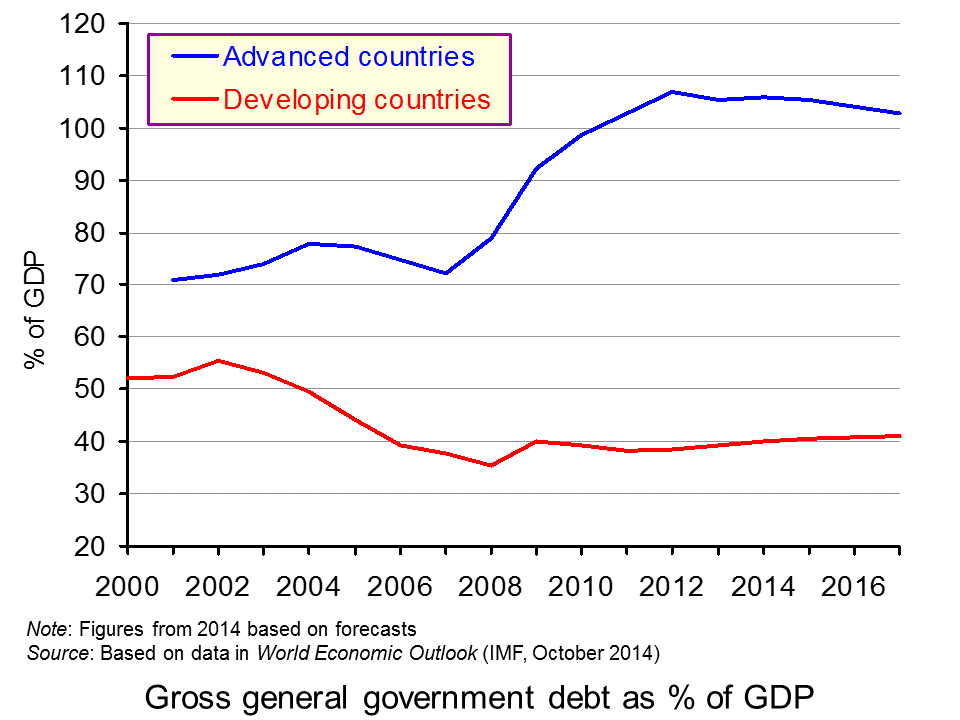 As far as public-sector debt is concerned, as a percentage of GDP its growth has begun to decline in advanced countries as a whole and, although gently rising in developing and emerging economies as a whole, is relatively low compared with advanced countries (see chart). Of course, there are some countries that still face much larger debts, but in most cases they are manageable and governments have plans to curb them, or at least their growth.
As far as public-sector debt is concerned, as a percentage of GDP its growth has begun to decline in advanced countries as a whole and, although gently rising in developing and emerging economies as a whole, is relatively low compared with advanced countries (see chart). Of course, there are some countries that still face much larger debts, but in most cases they are manageable and governments have plans to curb them, or at least their growth.
But there have been several warnings from various economists and institutes, as we saw in the blog post, Has the problem of excess global debt been tackled? Not according to latest figures. The question is whether countries can grow their way out of the problem, with a rapidly rising denominator in the debt/GDP ratios.
Only mass default will end the world’s addiction to debt The Telegraph, Jeremy Warner (3/3/15)
Questions
- What would be the impact of several countries defaulting on debt?
- What factors determine the likelihood of sovereign defaults?
- What factors determine the likelihood of bank defaults?
- What is meant by ‘leverage’ in the context of (a) banks; (b) nations?
- What are the Basel III regulations? What impact will they have/are they having on bank leverage?
- Expand on the arguments supporting the doomsday scenario above.
- Expand on the arguments supporting the optimistic scenario above.
- What is the relationship between economic growth and debt?
- Explain how the explosion in global credit might merely be ‘the mirror image of rising output, asset prices and wealth’.
- Is domestic inflation a good answer for a country to the problems of rising debt denominated (a) in the domestic currency; (b) in foreign currencies?
 Recently, US regulators have decided not to impose further increases in capital requirements on US large and mid-sized banks. The increased requirements, proposed in late 2023, would have been stricter than required under the Bank for International Settlements’ Basel framework1 and provoked a fierce backlash, involving public statements by senior bank executives, aggressive lobbying and extensive media campaigns, including an ad-spot during the Superbowl.
Recently, US regulators have decided not to impose further increases in capital requirements on US large and mid-sized banks. The increased requirements, proposed in late 2023, would have been stricter than required under the Bank for International Settlements’ Basel framework1 and provoked a fierce backlash, involving public statements by senior bank executives, aggressive lobbying and extensive media campaigns, including an ad-spot during the Superbowl. The issue focused attention on the capital banks hold to protect against insolvency and provoked discussion about how much of a capital buffer these institutions should have.
The issue focused attention on the capital banks hold to protect against insolvency and provoked discussion about how much of a capital buffer these institutions should have. As with any limited company, a bank’s capital is the difference between total assets and its liabilities. It is the funding provided by long-term investors. These are primarily shareholders, but also long-term debtholders. Bank capital acts as a buffer to prevent insolvency. Capital represents the amount that the value of assets have to fall before the bank is insolvent (value of assets is below liabilities). Higher capital provides a greater buffer. Lower capital provides a smaller buffer.
As with any limited company, a bank’s capital is the difference between total assets and its liabilities. It is the funding provided by long-term investors. These are primarily shareholders, but also long-term debtholders. Bank capital acts as a buffer to prevent insolvency. Capital represents the amount that the value of assets have to fall before the bank is insolvent (value of assets is below liabilities). Higher capital provides a greater buffer. Lower capital provides a smaller buffer.![]()
![]()
![]()
 However, the dangers of this shift were exposed during the 2008 financial crisis. The capital held by banks was very thin and not designed to cope with extremely stressful economic circumstances. Banks found they had insufficient capital to cover losses from big decreases in the value of their securitised debt instruments like CDOs (collateralised debt obligations) and struggled to raise additional capital from worried investors.
However, the dangers of this shift were exposed during the 2008 financial crisis. The capital held by banks was very thin and not designed to cope with extremely stressful economic circumstances. Banks found they had insufficient capital to cover losses from big decreases in the value of their securitised debt instruments like CDOs (collateralised debt obligations) and struggled to raise additional capital from worried investors. Figure 1 shows the changes to the average return on equity (RoE) and average tier 1 capital ratios for a sample of 10 G-SIBs as a result of Basel III. By 2022, all the banks had capital buffers which were well above the minimum required under Basel III for tier 1 capital – 8.5 per cent. The trade-off was that banks’ average return on equity was much lower – around 8 per cent in 2022, compared to 16 per cent in 2007.
Figure 1 shows the changes to the average return on equity (RoE) and average tier 1 capital ratios for a sample of 10 G-SIBs as a result of Basel III. By 2022, all the banks had capital buffers which were well above the minimum required under Basel III for tier 1 capital – 8.5 per cent. The trade-off was that banks’ average return on equity was much lower – around 8 per cent in 2022, compared to 16 per cent in 2007.  While banks have to be solvent, they have to manage their trade-off between liquidity and profitability carefully too. A commercial bank’s basic business model involves maturity transformation – transforming liquid deposits into illiquid assets, such as government bonds and loans, to generate profit. This requires balancing the desire for profitability with the liquidity needs of depositors. If banks get it wrong, then it can lead to a loss of confidence and a ‘run’ on deposits. This is what happened to both Silicon Valley Bank (SVB) and Credit Suisse. The failures of both institutions were not due to insufficient capital but poor liquidity management, which eventually caused a loss of confidence.
While banks have to be solvent, they have to manage their trade-off between liquidity and profitability carefully too. A commercial bank’s basic business model involves maturity transformation – transforming liquid deposits into illiquid assets, such as government bonds and loans, to generate profit. This requires balancing the desire for profitability with the liquidity needs of depositors. If banks get it wrong, then it can lead to a loss of confidence and a ‘run’ on deposits. This is what happened to both Silicon Valley Bank (SVB) and Credit Suisse. The failures of both institutions were not due to insufficient capital but poor liquidity management, which eventually caused a loss of confidence.  Once confidence is lost and there is a run on deposits, even a bank which has a capital buffer deemed to be more than sufficient is doomed to fail. Take Credit Suisse. It was subject to the Basel framework and had capital ratios similar to its ultimate acquirer UBS. However, it had a risky business culture that pushed the trade-off too much towards profitability. This led to repeated scandals, fines and losses, which caused investors to lose confidence in the institution.
Once confidence is lost and there is a run on deposits, even a bank which has a capital buffer deemed to be more than sufficient is doomed to fail. Take Credit Suisse. It was subject to the Basel framework and had capital ratios similar to its ultimate acquirer UBS. However, it had a risky business culture that pushed the trade-off too much towards profitability. This led to repeated scandals, fines and losses, which caused investors to lose confidence in the institution. How Silicon Valley Bank Collapsed in 36 Hours: What Went Wrong?
How Silicon Valley Bank Collapsed in 36 Hours: What Went Wrong? Ten years ago, the financial crisis deepened and stock markets around the world plummeted. The trigger was the
Ten years ago, the financial crisis deepened and stock markets around the world plummeted. The trigger was the  Expanding the economy was left to central banks, which kept monetary policy very loose. Rock-bottom interest rates were then accompanied by quantitative easing. This was the expansion of the money supply by central-bank purchases of assets, largely government bonds. A massive amount of extra liquidity was pumped into economies. But with confidence still low, much of this ended up in other asset purchases, such as stocks and shares, rather than being spent on goods and services. The effect was a limited stimulation of the economy, but a surge in stock market prices.
Expanding the economy was left to central banks, which kept monetary policy very loose. Rock-bottom interest rates were then accompanied by quantitative easing. This was the expansion of the money supply by central-bank purchases of assets, largely government bonds. A massive amount of extra liquidity was pumped into economies. But with confidence still low, much of this ended up in other asset purchases, such as stocks and shares, rather than being spent on goods and services. The effect was a limited stimulation of the economy, but a surge in stock market prices. It has already experienced
It has already experienced  Then there is a risk of a cyber-attack by a rogue government or criminals on key financial insitutions, such as central banks or major international banks. Despite investing large amounts of money in cyber-security, financial institutions worry about their vulnerability to an attack.
Then there is a risk of a cyber-attack by a rogue government or criminals on key financial insitutions, such as central banks or major international banks. Despite investing large amounts of money in cyber-security, financial institutions worry about their vulnerability to an attack.





